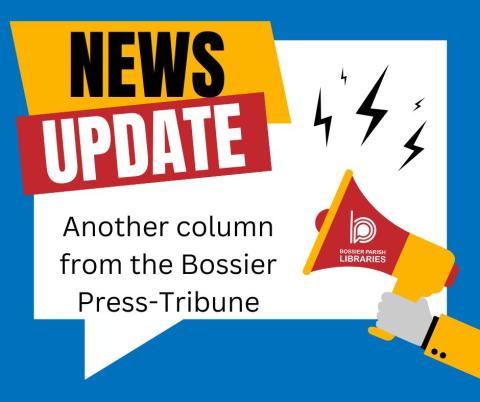
Looking at Earth (Day) with a View from the Moon
Earth Day, a celebration of clean air, land, and water, is coming up on Saturday, April 22nd. Earth Day began in 1970 as part of a newly-developing environmental movement. But did you know, the environmental movement really took off, so to speak, far away from the Earth, with the Apollo space missions?
The Apollo missions, which began in 1961 and concluded in 1972, resulted in inspiring photographic images of our startlingly blue orb of a planet set in stark contrast to the blackness of space. These included the first photo of the Earth taken from space by a human. It became known as the famous “Earthrise” photo of the Earth rising over the Moon’s horizon on Christmas Eve, 1968, from Apollo 8. Another famous image became known as the “Big Blue Marble” photo of the Earth on Dec. 7, 1972, from Apollo 17.
Perhaps the most famous of the Apollo missions was Apollo 11 of July, 1969, with its lunar landing module putting astronauts (Buzz Aldrin and Neil Armstrong) on the moon for the very first time. In 1989, the Shreveport Times did a 20-year story on locals’ memories of that day, with their own special connections to it. At least half of the group were Bossierites, Debo White Harris (now Dykes) then of Bossier City, and John and Maybelle Manry of Plain Dealing.
Mrs. Harris was one of the top finalists in the Teacher in Space program in 1985, and was a NASA space shuttle trainee. She spent eight days in 1986 at Cape Canaveral, Florida before the tragic launch of Space Shuttle Challenger, on which her friend and fellow teacher Christa McAuliffe perished. Following Challenger, Mrs. Harris (now Dykes) continued promoting space and science education, including as NASA Regional Resource Center at Bossier Parish Community College, supplying NASA materials and programs to schools within and beyond Louisiana.
Mrs. Harris said the moonwalk in 1969 played a part in what she has become: “I always had been a science buff. I used to think, ‘What I wouldn’t give to be up there.’” On that Sunday evening, July 20, 1969, teenaged Debo went outside her parents’ Bossier City home and looked up, wondering if she could see them (the Apollo crew and spacecraft) and imagined that she did. She dreamed of “floating” in space herself and how much fun that would be.
Though she didn’t make it all the way to space, Debo Harris Dykes did get the opportunity to experience that floating, weightless feeling after conceiving of an antigravity teaching project, Project Oeillades. Launched by NASA, with the participation of space shuttle commander and Air Force Col. Brewster Shaw, to help school kids understand Newton’s laws of physics, the project took flight in Fall 1988 with Mrs. Harris and Col. Shaw in a padded cabin in a Reduced Gravity Aircraft (KC-135). Mrs. Harris made 14 flights into weightlessness to demonstrate crucial laws of physics by videotaping experiments with simple toys such as a football, a hula hoop, and a seesaw.
John Ardis Manry was a printer, regional historian, photographer, and genealogist who for a while was publisher of the Bossier Banner newspaper and worked for the Shreveport Times. He was born two weeks before brothers Orville and Wilbur Wright took their famous flight in December, 1903. (He passed away in 1993). He remembers the “pop-pop-pop” sounds of the first Model T Ford automobiles keeping neighbors awake in Plain Dealing. He watched the first hot air balloon liftoff from Bossier Parish soil in 1915 and thought that the pilot “had gone to heaven right there.”
The moonwalk “was the greatest thing that ever happened in my 85 years,” he said. Mrs. Manry said that was “probably because we had a child involved in it.” At the time, their son Charles, a graduate of Georgia Tech University, was working for NASA’s Manned Space Center, Guidance and Control Section. He later worked for Martin Marietta in Denver. He passed away in Colorado in 2011.
Charles’ proud parents remembered of Apollo 11, “We saw every bit of it we could and we read everything we could.” Raising their kids in Plain Dealing in the 1930’s, they wouldn’t have imagined anything like the Apollo program, Mr. Manry said. In fact, he reminisced, the most fantastic thing they’d personally seen was the sending of the first newspaper wire photo in 1935, “a marvel.” Mrs. Manry added that when she was young, “I thought everything in the world had been discovered that could be discovered. There was nothing else. Just look at what we’ve done since I grew up.”
If you have stories or photographs of some of the area’s space or environmentally-minded citizens, we’d love to see or hear them, and perhaps make copies for our collection, with your permission. The Bossier Parish Libraries History Center located at 2206 Beckett St, Bossier City, LA and are open M-Th 9-8, Fri 9-6, and Sat 9-5. Our phone number is (318) 746-7717 and our email is history-center@bossierlibrary.org
For other fun facts, photos, and videos, be sure to follow us @BPLHistoryCenter on FB, @bplhistorycenter on TikTok,
Images:
- Debo White Harris Dykes “floats” through a hula hoop in the weightlessness of NASA’s training jet. (Photo taken for Florida Today, 17 September 1989.
- Photograph of Maybelle Francis and John Ardis Manry on their 50th Wedding Anniversary, Oct. 17,1977.
- Photograph of Charles Manry playing in the Coushatta Bluffs near Plain Dealing, LA c. 1951.
Article by: Pam Carlisle